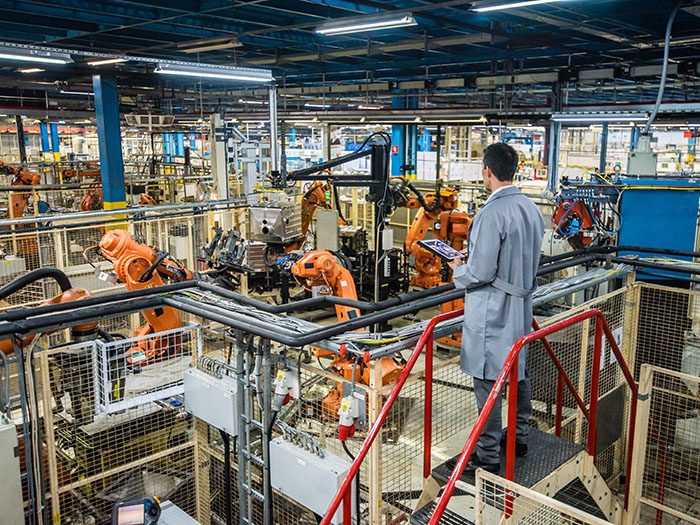Manufacturing
9 Critical Risks Facing the Manufacturing Industry

The pace of global trade will continue to generate manufacturing orders, and demand for manufactured goods is rising. Industrial output in 2018 is projected to increase by 3.8 percent globally.
By 2020, manufacturing’s share of GDP will exceed 20 percent in the top 60 largest global economies. Yet political shifts, rapidly evolving technology and the decline of new talent entering the industry present challenges.
1) Tariff Wars
Manufacturers with a heavy reliance on foreign steel and aluminum will face significant cost increases, which would likely cut into profits and potentially even spur layoffs. U.S. steel prices are already almost 50 percent higher than those in Europe or China, and aluminum prices are seen as volatile.
Retaliatory tariffs from the EU, Canada and Mexico will also be a blow to many manufacturers exporting goods.
The EU’s recently announced plan would also impose duties between 10 and 50 percent on $4.2 billion worth of U.S. goods, including orange juice, bourbon, jeans, motorcycles and certain steel products. Canada placed tariffs on $12.9 billion worth of U.S. goods while Mexico placed tariffs on a variety of U.S. products.
Ultimately, these tariffs collectively are likely to slow job creation and could negatively offset the gains achieved through tax and regulatory reform.
2) Shrinking Talent Pool
The manufacturing industry has an image problem. A 2017 perception study published by Deloitte and the Manufacturing Institute noted that less than three in 10 Americans surveyed would encourage their children to pursue a manufacturing career. A majority made negative assumptions about the stability, growth opportunities and salaries in the industry.
At the same time, experienced workers are reaching retirement age in droves, and the skill sets needed by manufacturers are shifting due to evolving technologies. An earlier study by Deloitte and the Institute concluded that of the 3.5 million manufacturing jobs needed through 2025, two million of them would go unfilled due to the skills gap.
Manufacturers must engage the future workforce at the high school and college level, emphasizing technological advances, meaningful work and a positive work environment.
3) The Pace of Change
Industry 4.0, or the Industrial Internet of Things, refers to the gradual absorption of traditional manufacturing into the technological and connected world. The overall end goal is increased automation, improved communication and monitoring, along with self-diagnosis and new levels of analysis between machines and systems.
But the challenges of achieving this manufacturing nirvana are not small. Entirely new frameworks of cyber security need to be developed in order to protect people, physical assets, as well as customer and intellectual property data. A smart factory, fully integrated and connected with sister factories all over the world, makes for an all-too appealing attack target.
Maintenance of these modern systems presents additional risk exposure. Current maintenance personnel don’t always receive adequate training and many are at least partly self-taught. The most knowledgeable and experienced among them are at or near retirement age.
Smart factories without adequately trained maintenance staff run the risk of extended downtimes and lost profits.
4) Growing Acceptance of Marijuana
 At the time of this writing, the White House signaled its potential support for amending the federal Controlled Substances Act to exempt state-legal marijuana activity.
At the time of this writing, the White House signaled its potential support for amending the federal Controlled Substances Act to exempt state-legal marijuana activity.
That would be a game-changer for employers, because the substance’s federal legal status has been the linchpin of most employment practices legal battles involving state-legal marijuana use.
Manufacturing employers have significant reason to be concerned, as most rely on zero-tolerance policies to protect workers in safety-sensitive manufacturing environments.
Current THC testing methods don’t measure impairment levels, and most supervisors don’t have adequate training on how to identify a worker who’s under the influence of cannabis.
5) Safety
High turnover and tight staffing create an environment with a reduced emphasis on safety culture. Experienced workers are stretched thin and have little time to train and mentor new hires. Inexperienced workers in a manufacturing environment are at high-risk for injuries, especially within their first six months of employment.
Increased overtime and 24/7 operations also lead to fatigue, sharply increasing the risk of serious injuries or fatalities.
6) Robot Proliferation
More than 3 million industrial robots will be in use in factories around the world by 2020, according to the International Federation of Robotics. Robots have the potential to offset the talent gap and increase productivity, but risks abound.
Liability issues surrounding product defects, personal injury or property damage are murky at best, and manufacturers could be forced to defend themselves against claims actually caused by hardware or software defects.
7) Cyber Vulnerability
In a 2016 survey, 31 percent of manufacturing respondents admitted they had never performed a cyber risk assessment of their industrial control systems.
But cyber security has never been a more vital part of manufacturing operations. Cyber security firm Malwarebytes tracked a 90 percent increase in the number of detected ransomware attacks in 2017, noting that the 2017 monthly rate of ransom-related attacks increased up to 10 times the rate observed the prior year.
Security vulnerabilities increase the risk of hackers tampering with systems or even shutting down an entire production line until their demands for payment are met.
8) Supply Chain
In the era of lean manufacturing, projects are typically time, cost and quality sensitive, leaving little room for delays. Manufacturers that can’t deliver on their promises because of a supply chain stall risk losing out on millions of dollars in potential revenue and profit.
Anything from grounded flights to cargo theft to quality control issues can impact the flow of goods from a supplier. Not having a reliable back-up supplier may cause operations to grind to a halt, leading to losses and damaging a company’s reputation.
Even if vendors have been steady and reliable for years, steady increases in the volume and severity of natural catastrophes ups the chances that a key supplier could be impacted by a disaster.
9) Third-Party Vendors
Shortcomings on the part of third-party vendors can expose manufacturers to a variety of risks. Cyber security weaknesses are of particular concern for any vendor with access to employee or customer information.
In addition, manufacturers can be held accountable for certain types of compliance lapses by third parties. A thorough risk assessment of key vendors is a necessity. &










